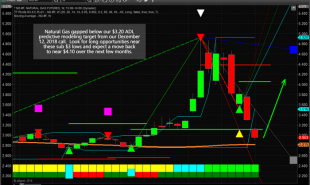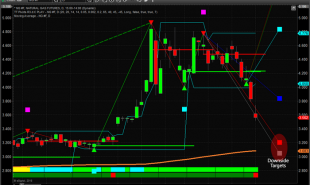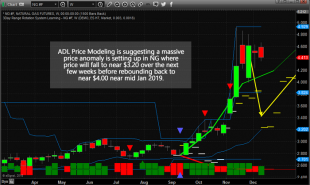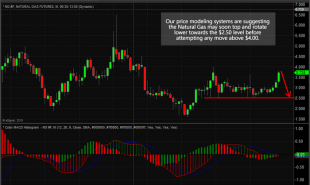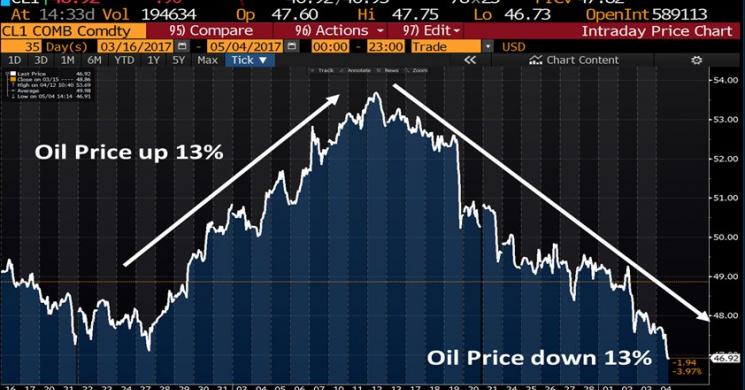
Weekly EIA Report – 5-5-17 Oil: Death By Consensus
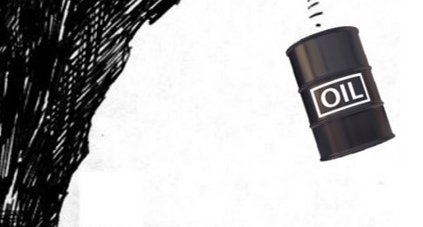
See our OPEC Deal Tracker at the end of the newsletter for our ongoing analysis of the OPEC cuts.
When investing, it is important not to act like a lemming. Lemmings are snow-bound rodents which, according to popular myth, stick together and follow each other even when doing so obviously leads to a certain and brutal death. This alleged suicidal behaviour has been the theme of many books and games, and many of you will have seen images of hordes of lemmings queuing up to jump off a cliff. Sadly, it seems the majority of oil commentators are advocating that you do just that: Ignore the reality of the market, buy some of oil futures, and join the queue to jump off the cliff. In fact, Reuters was kind enough to conduct a poll of these commentators, and the results easily prove my point: out of 35 analysts polled, the lowest prediction for the average value of Brent in 2017 was US$ 51 per barrel. The highest… US$ 63! So if they are worth their salt, and Reuters, who polled them, must certainly think they are, with Brent currently trading at US$ 48, you must be buying like mad! Or should you be?
The consensus these analysts have expressed is simple. OPEC and its allies are mostly complying with the planned cuts, they will most likely renew their deal when they meet at the end of May, and robust demand growth will do the rest. The result, again according to the poll, will be that crude oil stocks will have “normalised” back to their five year average by the end of the year. Taken at face value, such talk can appear compelling, and the unanimous nature of the proclamation could easily make you wonder what Magma has been complaining about for the last few months… until you look beyond the proclamations and the hard data.
First you will notice these oil prophets have a dismal track record at predicting what is going to happen in the market. Don’t get me wrong, they are quite good at reviewing the past, but not so when it comes to the future. Not one of them saw the fall below triple digit oil in 2014. They then spent all of 2015 telling you the market was on the verge of turning around, and when we hit the US$ 20’s in early 2016, they all predicted oil would not rally so soon. They then spent all of the rest of the year telling us the worst was over and cheerleading the rally. I have lost count of how many times the market was already rebalanced in 2016. They also previously believed there would be a deficit in Q1, that shale would fail to recover and that stocks would be normalised by the end of Q2. None of the above happened. Having looked at this, ask yourself: Are these the people whose advice, however unanimous it might be, you should be following?
Before the oil deal was even signed, we warned you prices would try to climb towards US$ 60, and that once a few OPEC reports had demonstrated failure, the market would head south. That is because we like to follow fundamentals as well as sentiment. It is also because unlike the 35, we understand the basic economic concept that higher prices motivate more production. But let’s get back to fundamentals. OPEC and Non-OPEC compliance are indeed rumoured to be closer to 100%. Now this is quite impressive on its own, but the reality is, as we have repeatedly pointed out, we at Magma always operated under the assumption that this would be the case. It also appears OPEC will renew the deal… We at Magma always said the deal would have been pointless if it stopped before the summer gasoline season. So neither compliance nor extension are new factors in our analysis, and as we told you a couple of weeks ago, neither matters any longer.
What does matter is that they believe in robust demand growth. The bellweather for such growth is usually US gasoline demand which has been hovering about 3% down year on year so far in 2017. At some point, one of the 35 should explain to you where the robust growth will come from since at the moment, we cannot even keep up with 2016.

US Gasoline Demand (Source EIA – In thousands of barrels)
Overall, the respondents to the poll do not just have credibility issues. In their haste to encourage you to buy, they are ignoring all contradictory data. Libya’s production has apparently reached 760,000 barrels a day, which would put it more than 230,000 barrels over its October levels. US Shale production has reached 9.293 million barrels a day, a number the EIA said would not be reached before December. That is 843,000 barrels of increased production… But wait a minute… I may not have voted in the Reuters poll, but I can add (on good days I can even multiply!) 843,000 plus 230,000, that is 1.073 million barrels of “new”, (unexpected by OPEC or the 35) production. This means that fundamentally, more than 85% of the OPEC cut may have been neutralised if Iran and Nigeria have not had any unplanned outages. I have yet to see anyone but Magma point this out. More importantly, it seems investors are starting to realise that the respondents to the poll may have lost their grip on reality. How else can you explain Thursday’s 5% drop in price?

(Source: EIA - Production in Thousand Barrel Increments)
So, I urge you, do not become lemmings. This market rally has been propelled by exaggeration, wishful thinking, propaganda, and most importantly, blatant disregard for facts: Higher prices motivate more shale production… US demand is down… there was a daily surplus of 430,000 barrels a day in Q1 according to the last OPEC report. The recent slew of excellent oil company results should tell you all you need to know; costs are down all over the industry and even offshore production in the Gulf of Mexico is growing. Most importantly remember one important detail: if you turn into a lemming, and take that dive off the cliff, the 35 will not be diving with you, they will most likely be sitting on the beach like Olympic judges, grading your fall, and explaining to everyone else that YOU failed to see the signs.
But before we talk about the EIA report, I have decided to Poll myself and here are the highly precise results. I expect the average price of Brent this year to be at US$ 41, and WTI at US$ 38. We will also see WTI in the US$ 20’s. I also predict that stocks will not have normalised this year, on the contrary, they will have grown. Yet beware of the 35 and their lemmings, they may yet help the market tread water and recover some of the ground lost. But also remember that every cent they make upwards motivates more production, and that, in the end, will be their downfall.
Last week US crude stocks declined 930,000 barrels, a dismal number when you consider US refineries are running more than a million barrels above where they were running the same time last year. With strong US exports, we should be seeing much bigger draws in stocks… Maybe the OPEC cuts aren’t working? Brent time spreads continue to deteriorate and should be sold whenever they are close to 10 cents Contango. Prices have broken the 200-day average to the downside, but they are likely to find some support here as we wait for OPEC’s next report which will be published next Thursday. Look for Brent to have a technical bounce and try to return to the US$ 51.50 area.

US Commercial Crude Stocks…Small decrease… (Source: EIA)
(High/Low/Average Range over five years in thousand barrel increments)
With US refineries working harder than they ever have, even good distillates demand is failing to really dent stock levels which declined 562,000 barrels. The only way out for US refiners is to export distillates hand over fist, and we expect this to have a depressing effect on Europe. We are still short the back-end of the 2017 gasoil curve in Europe and happily so. We expect some sort of a technical bounce in the US heating oil margins and we would sell if they go near US$ 16.

Distillate Stocks… Sideways… (Source: EIA)
(High/Low/Average Range over five years in thousand barrel increments)
Gasoline demand is consistently disappointing this year and stocks increased 191,000 barrels, continuing to track 2016. With lower demand and higher refining, we expect things to be worse in 2017. If margins go back near US$ 19, we will sell them.

Gasoline Stocks… a bit more… (Source EIA)
(High/Low/Average Range over five years in thousand barrel increments)
Refining continues its stunning performance and remains well above the 17-million-barrel mark. This bodes ill for oil products this year. Expect a product glut… again! It must be a wonderful time to own a petrol station!

US Refining… It has the POWER!! (Source: EIA)
(High/Low/Average Range over five years in thousand barrel increments)
THE OPEC DEAL TRACKER
Please note that other than our future predictions for exempt nations, shale and OPEC underestimation, we only use official numbers from OPEC and the EIA. Only official numbers can modify our estimates. The OPEC numbers for the first quarter showed a 430,000-barrel surplus. Please note that according to our table, the average increase in US production was 262,000 barrels and the exempt nations added an average 156,000 barrels. Add our 70,000 barrels of disagreement with OPEC, and you get 490,000 barrels. Not bad if you ask me! Assuming full compliance for the rest of the year, although that is unlikely, the situation is as follows:

(Source: OPEC/EIA
(Green Cells are official OPEC numbers - yellow cells show the data according to the variables selected by Magma)
THIS WEEK:
- US production has now grown 523,000 barrels in 2017.
- Exempt nations Libya, Iran and Iraq are 105,000 barrels above their October 2016 levels
- With 100% compliance, we now expect an average daily surplus of 350,000 barrels in 2017
- There will not be a deficit in Q1 or Q2 (Stocks will increase all the way until the end of Q2)
- Stocks will increase during 2017
- US Oil Production has almost reached 9.3 million barrels a day and will likely be near 10 million barrels a day by the end of the year
Magma’s Assumptions:
- OPEC compliance is assumed to be 100% until official numbers change them.
- Iran, Libya and Nigeria will together add 100,000 barrels a day per quarter
- Shale will add 200,000 barrels a day per quarter
- OPEC is underestimating production by 70,000 barrels a day per quarter in its assessment in a variety of locations
OPEC’s Ideal outcome:
OPEC has agreed to cut production to 32.5 million barrels (Including Indonesia) Non-OPEC nations have agreed to cut a further 558,000 barrels, bringing the total cut to 31.95 million barrels. OPEC’s base case assumes no other producer fills the gap. Now with the February report, Indonesia has been moved from OPEC to the rest of the world, so the planned production level will be about 31.25 million barrels a day. With the January numbers, the “perfect outcome” looks like this:

(Source: OPEC)
OPEC has now decreased its demand estimates. It is now official, there was a surplus in Q1 and even if the rest of the year goes like a charm, there won’t be a significant deficit until summer, so no stocks on the five-year average by then.
Read more by Soren K.Group



